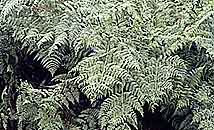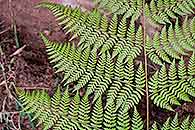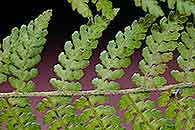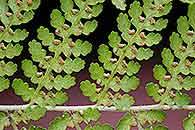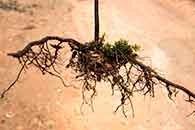Hypolepis sparsisora (Schrad.) Kuhn
Synonyms |
Hypolepis anthriscifolia (Schltdl.) C. Presl |
|---|---|
Common name |
|
Description |
Rhizome widely creeping, subterranean, up to 5-9 mm in diameter; rhizome hairs pale brown, c. 1 mm long. Fronds widely spaced, finely divided, glabrous, erect. stipe up to 1 m long, glabrous at maturity, pale brown. Lamina 1 × 0.8 m, ovate in outline, 3- to 5-pinnatifid. Pinnae spreading horizontally, ovate-deltate in outline; ultimate pinnules oblong-lanceolate in outline, apex pointed, margins crenate to pinnatifid with bases joined to the costules. Rhachis pale-brown, glabrous. Sori small, 0.5-1 mm wide, oval, borne singly in the sinuses between the lobes; indusium subentire, elongate, semi-transparent. |
Notes | Differs from other species by having a soft lamina texture and finely divided fronds (4- to 5-pinnatifid). Can be distinguished from Microlepia speluncae by having a glabrous lamina and pinna that are set at right angles to the rachis. Hypolepis sparsisora favours high-light conditions whereas Microlepia speluncea prefers shaded areas. |
Derivation | sparsisora: scattered, sparse sori; one thought that this species had fewer sori than most others in the genus. |
Habitat | In wet upland and evergreen forest that receives high rainfall and/or frequent mist, streamside and swampside forest and thicket, sometimes in gullies and in clearings with high light levels. |
Distribution worldwide | Widespread in Africa and Madagascan region. |
Distribution in Africa |
Burundi, Cameroon, Dem. Republic of Congo, Equatorial Guinea (incl. Bioko), Ethiopia, Kenya, Liberia, Malawi, Mozambique, Rwanda, Sierra Leone, South Africa, Swaziland, Tanzania , Uganda, Zimbabwe. |
Growth form |
Terrestrial. |
Literature |
|

